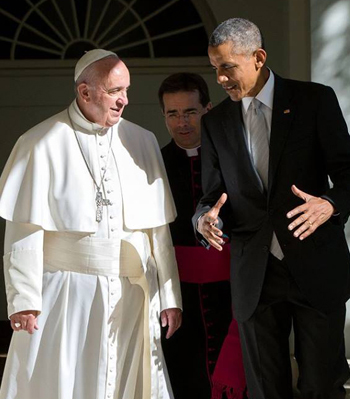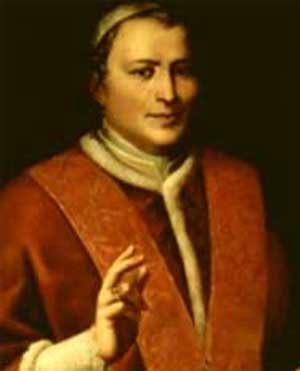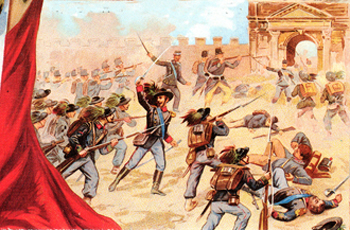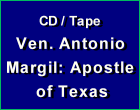American History
 |
 |
 |
 |
 |
 |
 |
U.S. Diplomatic Relations with the Vatican:
Only
under Pius IX & John Paul II
Concerning the discussion as to whether or not Cardinal Mastai-Ferretti, later Pope Pius IX had been a Mason in his early years
[here and here], please allow me “to throw into the pot” something that I recently found.
Perhaps many American Catholics are unaware of this fact but, for most of the History of the United States, diplomatic relations with the Holy See did not exist. This fact is an unfortunate consequence of the anti-Catholicism that was largely promoted by Masonic and Protestant forces in this country. Today, this notorious stain on our nation’s history has become common knowledge.
 But, in 1984, in the aftermath of the Second Vatican Council, the Holy See and the United States established diplomatic relations. John Paul II was, then, leading the “Conciliar Revolution,” which was destroying Church defenses against her enemies such as Freemasonry. “Positive” diplomatic relations between the two States have continued to this day under Pope Francis, according to the Fact Sheet of October 17, 2016, posted on the U.S. Department of State website, which reads:
But, in 1984, in the aftermath of the Second Vatican Council, the Holy See and the United States established diplomatic relations. John Paul II was, then, leading the “Conciliar Revolution,” which was destroying Church defenses against her enemies such as Freemasonry. “Positive” diplomatic relations between the two States have continued to this day under Pope Francis, according to the Fact Sheet of October 17, 2016, posted on the U.S. Department of State website, which reads:
“The United States and the Holy See consult and cooperate on international issues of mutual interest, including human rights, peace and conflict prevention, poverty eradication and development, environmental protection and inter-religious understanding.
"Since his inauguration, Pope Francis has acted as a global advocate of human dignity and justice, specifically in his emphasis on the moral imperative of ending trafficking in persons and caring for the poor and marginalized. The United States and the Holy See enjoy a positive relationship that serves to amplify a global message of peace, hope and justice.”
Pius IX established diplomatic relations with U.S.
There was only one other time in American History where relations rose to diplomatic status between the United States and the Vatican: It was from 1848 to 1868, in the early part of the long reign of Pius IX (1846-1878). As we read, again, from the Fact Sheet of the State Department:
 “The United States maintained consular relations with the Papal States from 1797 to 1870 and diplomatic relations with the Pope, in his capacity as head of the Papal States, from 1848 to 1868. … These relations lapsed in 1870 and with the loss of all papal territories during the unification of Italy. From 1870 to 1984, the United States did not have diplomatic relations with the Holy See.”
“The United States maintained consular relations with the Papal States from 1797 to 1870 and diplomatic relations with the Pope, in his capacity as head of the Papal States, from 1848 to 1868. … These relations lapsed in 1870 and with the loss of all papal territories during the unification of Italy. From 1870 to 1984, the United States did not have diplomatic relations with the Holy See.”
In other words, “consular relations” were established in 1797 (10 years after the signing of the U.S. Constitution in 1787); these were elevated to “diplomatic relations” from 1848 to 1868. But by 1870, both relations broke down for 114 years until 1984 in the pontificate of John Paul II.
The Fact Sheet of the State Department implies that diplomatic relations were established and dependent on the existence of papal territories. But this is not true since, by 1848, the U.S. was over 60 years old and the Papal States had been around for over a thousand years. Why weren’t diplomatic relations established during the previous pontificates of Pius VI, Pius VII, Leo XII, Pius VIII or Gregory XVI? Why were they established – and for just 20 years – only in the early pontificate of Pius IX.
Also, why were diplomatic relations ended in 1868, as the Fact Sheet states, if the Papal States where not lost until 1870?
Below, I list more serious reasons for the ending of the short-lived diplomatic relations in 1868:
Today we know that the Freemasonry is quite pleased with the Conciliar Popes. The Masons themselves have signified it many times either by public declarations or symbolic gestures in support of these Popes. It is understandable, therefore, that our country, being a strong adept of Freemason ideals, would establish diplomatic relations with them.
So, the same logic leads me to suppose that in the first part of his pontificate Pius IX raised analogous sympathies from our governors. This would explain why the U.S. had diplomatic relations with the Vatican at that time.
If Vatican II opened the windows of the Church to the world, what was opened to the world with the election of Pius IX to the papacy? It seems to me that everything speaks in favor of some opening existing, which attracted forces that are opposed to the Catholic Church. Was it because Freemasonry saw Pius IX as one of their own? Or were his early liberal positions sufficient to increase those liaisons with anti-Catholic forces?
I believe that it is safe to say that Masonry clearly saw a great asset in the elevation of Card. Mastai-Ferretti to the Papacy. But, fortunately, their cause for celebration was short-lived with the gradual but profound conversion of Pius IX into one of the greatest Popes of modern times.

Perhaps many American Catholics are unaware of this fact but, for most of the History of the United States, diplomatic relations with the Holy See did not exist. This fact is an unfortunate consequence of the anti-Catholicism that was largely promoted by Masonic and Protestant forces in this country. Today, this notorious stain on our nation’s history has become common knowledge.

Francis & Obama, perfect agreement on their socialist goals
“The United States and the Holy See consult and cooperate on international issues of mutual interest, including human rights, peace and conflict prevention, poverty eradication and development, environmental protection and inter-religious understanding.
"Since his inauguration, Pope Francis has acted as a global advocate of human dignity and justice, specifically in his emphasis on the moral imperative of ending trafficking in persons and caring for the poor and marginalized. The United States and the Holy See enjoy a positive relationship that serves to amplify a global message of peace, hope and justice.”
Pius IX established diplomatic relations with U.S.
There was only one other time in American History where relations rose to diplomatic status between the United States and the Vatican: It was from 1848 to 1868, in the early part of the long reign of Pius IX (1846-1878). As we read, again, from the Fact Sheet of the State Department:

Pope Pius IX, a liberal in the first part of his pontificate
In other words, “consular relations” were established in 1797 (10 years after the signing of the U.S. Constitution in 1787); these were elevated to “diplomatic relations” from 1848 to 1868. But by 1870, both relations broke down for 114 years until 1984 in the pontificate of John Paul II.
The Fact Sheet of the State Department implies that diplomatic relations were established and dependent on the existence of papal territories. But this is not true since, by 1848, the U.S. was over 60 years old and the Papal States had been around for over a thousand years. Why weren’t diplomatic relations established during the previous pontificates of Pius VI, Pius VII, Leo XII, Pius VIII or Gregory XVI? Why were they established – and for just 20 years – only in the early pontificate of Pius IX.
Also, why were diplomatic relations ended in 1868, as the Fact Sheet states, if the Papal States where not lost until 1870?
Below, I list more serious reasons for the ending of the short-lived diplomatic relations in 1868:
- Conversion of Pius IX: It is widely known that Giovanni Maria Mastai-Ferretti was liberal prior to being elected Pope and that these sad inclinations accompanied him into the early years of his papacy. But, with his correspondence to divine grace and increasing confrontations with Freemasonry, Pius IX eventually became the great man admired today by faithful Catholics. I believe the conversion of Pius IX and the attacks of Masonry are major causes of the end of diplomatic relations between the U.S. and the Holy See.
- American Civil War: From 1861 to 1865, America was in a bloody Civil War and, during this conflict, Pope Pius IX was, to my knowledge, the only Head of State in the world who recognized the Southern Confederacy. In a letter responding to Jefferson Davis, Pius IX addressed the Confederate President as “Honorable President of the Confederate States of America” and included an autographed picture. In the meantime, Karl Marx and Fredrick Engels sent letters of support to Lincoln in the North. Such a situation, followed by the victory of Lincoln and the brutal “reconstruction” of the South, would also contribute to ending diplomatic relations by 1868.
- Garibaldi and the invasion of the Papal States: Shortly before 1868 (October 1867), there was a failed attempt by the Masonic forces of Garibaldi to take Rome and the Papal States and revolutions fomented inside Rome were unsuccessful. With the help of known Mason Otto von Bismarck, Chancellor of the Prussian Empire, Garibaldi eventually succeed in taking Rome in 1870. This is another reason why diplomatic relations ended in 1868 and all relations ended in 1870.
- The declaration of Papal Infallibility: The last straw for Masonry was the declaration of papal infallibility, as Prof. Plinio Correa de Oliveira explains in his article,
The Grandeur of Pius IX in the Fight for the Papal States. Bismarck of Prussia warned Pius IX not to declare that dogma during the First Vatican Council. Should he do so, Prussia would declare war on France, and France would be forced to recall its troops protecting the Papal States, thus leaving the Pope vulnerable to the advances of Garibaldi.
Historically, that is exactly what happened. On July 18, 1870, the dogma of Papal Infallibility was declared; the day after, on July 19, 1870, Bismarck declared the Franco-Prussian war and Napoleon III recalled to France his troops that were defending Rome. On September 11 of that same year, the forces of Garibaldi advanced toward the city of Rome. They entered Rome on September 20 and annexed it to the Masonic Kingdom of Italy. One month later, on October 20, Pius IX suspended Vatican Council I, to be continued at a later date. By June 1871, the capital of the Kingdom of Italy was officially moved from Florence to Rome.

Garibaldi's troops attacking Rome
Today we know that the Freemasonry is quite pleased with the Conciliar Popes. The Masons themselves have signified it many times either by public declarations or symbolic gestures in support of these Popes. It is understandable, therefore, that our country, being a strong adept of Freemason ideals, would establish diplomatic relations with them.
So, the same logic leads me to suppose that in the first part of his pontificate Pius IX raised analogous sympathies from our governors. This would explain why the U.S. had diplomatic relations with the Vatican at that time.
If Vatican II opened the windows of the Church to the world, what was opened to the world with the election of Pius IX to the papacy? It seems to me that everything speaks in favor of some opening existing, which attracted forces that are opposed to the Catholic Church. Was it because Freemasonry saw Pius IX as one of their own? Or were his early liberal positions sufficient to increase those liaisons with anti-Catholic forces?
I believe that it is safe to say that Masonry clearly saw a great asset in the elevation of Card. Mastai-Ferretti to the Papacy. But, fortunately, their cause for celebration was short-lived with the gradual but profound conversion of Pius IX into one of the greatest Popes of modern times.

Posted May 3, 2017
______________________
______________________








